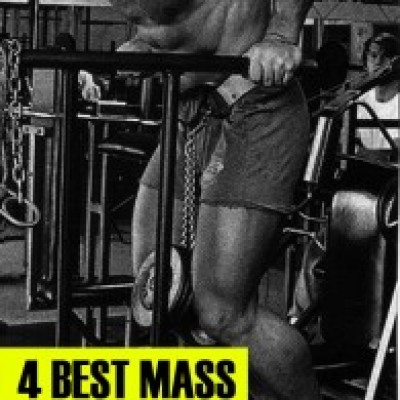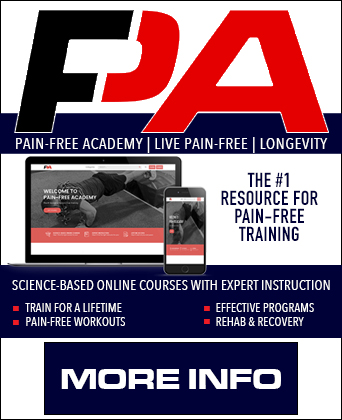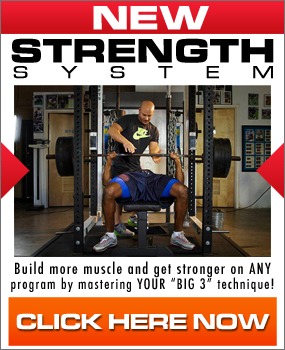4 Strength Training Tips You Won’t Find in Books

While some trainers have ‘book smarts’ and some trainers have ‘under the bar’ experience; it is the ones that have both, who get long-term results and really connect with their athletes.
Knowledge gained through books can provide “why” something works or even how everything is integrated together, but applying this knowledge isn’t as straight forward or as easy as many references might lead you to believe.
That is the real skill of coaching; knowing the ‘why’ and finding a way to implement it for each unique athlete. It will also show your athletes that you really care and take their development seriously.
Here are some “tricks” I have learned over the years that allowed progress to continue, when the “standard” routine or program wasn’t quite right.
Bar Work is Not For Everyone

Get Your Own Multi Grip Bar – CLICK HERE
When athletes come into my program, they have to ‘earn the right’ at each level of the system to progress to more advanced training means.
For example, progression must be earned from push-ups to various other barbell work for the upper body, like bench pressing. And, once they do get on the bar, we must determine if that is the right tool for them to use.
You might find that a barbell just doesn’t work with an athlete and actually causes more problems than it’s worth. They start getting pain in their shoulders, wrists or elbows, or they can’t maintain tension at a certain point in the lift.
You can get the same training effect, increase the intensity of the exercise and progress without having to regress backwards, just by finding another way that works.
Challenging the athlete in this manner will give them more confidence and keep them motivated. It is really disheartening for them to see all of their teammates crushing barbell bench, and they’re stuck on push-ups.
It will also give you the opportunity to continue working on their restrictions and finding out ‘why’ the barbell didn’t work for them.
Was it a technique issue? A weakness? A restriction?
Neutral grip benching with Fat Gripz is an amazing pressing variation that is a much better option for many athletes. It puts the shoulders in a much safer position and the wide grip of the Fat Gripz takes the pressure off of the wrists and elbows; as I discussed in my Pressing for Older Lifters series. And I’ve found that teaching the athletes to turn on the lats with a neutral grip, is much easier than with a barbell.
Some Athletes Don’t Get It (or Can’t Get It)

Get Your Elastic Bands at Rogue – CLICK HERE
Telling an athlete to get tight or ‘squeeze your glutes’ doesn’t always work. Yes, when they’re standing or they’re in a good position for them, they can ‘turn on’ their glutes; but what if that position isn’t good for them or it is outside of their normal mobility range. When they’re in a restricted position, I’ve found they have a very hard time creating an isometric contraction and ‘activating’ the targeting muscle group.
One example might be trying to get some PNF work in a rear foot elevated split squat (RFESS).
You’ve all seen the band-resisted squat where the band is placed around the low quad position for the athlete, and they’re asked to squat. This is used to eliminate valgus collapse of the knees, i.e., the band forces the athlete INTO the common compensation (valgus) and their subsequent reaction is to learn how to force their knees out as they squat. It also increases the glute engagement and tension. This will help to build more stability through the full range of motion.
What if we use the same band setup for hip thrusts (Bret Contreras)? We take away the gravity and stabiity aspect associated with squats and we move them to a more optimal position with an exercise that has been shown to activate the glutes like crazy.
We allow the athlete to “feel” how to turn on their glutes which will carryover to every lower body movement; drive phase and lockout position for kb swings, deadlifts, squats, reverse hypers, good mornings, etc..
Again, there is always a way to get what you need done. You just have to find the “trick” for that athlete.
Not Everyone Can Be a Powerlifter

Check out Rogue’s Squat Bar – CLICK HERE
Box squats and squats to a box have become pretty common in most programs. I talked about using both of them in the Simple Squat Progression series before. I also mentioned the tip that most athletes, in an attempt to squat more weight, like to ‘rock on the box’ and use this momentum to get out of the hole.
Yes, this technique is used by elite powerlifters, but athletes are not elite powerlifters. A safer and more beneficial technique is to have the athlete touch the box softly – without losing tension across their hips and torso – and then drive back to lockout, i.e., straight off the box.
Athletes interpret the “rock technique” as they should unlock at the low back or torso, instead of keeping everything rock solid, and ONLY unlocking at the hips. This subtle difference is very difficult to learn.
So, have your athletes maintain tension through the entire range of motion, and touch-and-go (don’t crash) on the box.
Side Note: If at some point along the range of the squat they lose tension, move the box up. Only work through a range where they can maintain position and tension. Work on their mobility at the hips and upper back and make their core strength a priority.
Boards Can Mess You Up

Check Out the Rumble Roller – CLICK HERE
Board pressing is a great way to overload the triceps, keep you out of an end-range position that can irritate the shoulder, and help you work on weak points along your bench path.
But, they can also keep you from progressing to a bigger bench press.
What typically happens when your athletes board press? They drop the weights on the boards and then try to drive back to lockout.
Does that sound familiar?
It is exactly like them crashing on the box for squats; just for the upper body.
Both techniques ‘disrupt’ their full body tension and then they are forced to try and regain this tension at a less than optimal position.
The better technique is to try and maintain a high-level of tension throughout the lift and not ‘relax’ or have their chest collapse when the bar hits the boards. (same as the touch-and-go technique for squats to a box).
One technique I really love is replacing the boards with a foam roller. This is much easier on the shoulders during the transition from the eccentric to concentric phases and gives the athlete a slight boost out of the hole. We’ve used 1/2 foam rollers and full foam rollers with this setup. Again, I detail this technique in my Pressing for Older Lifters series.
Try out these techniques and let me know in the comments if they helped you to ‘reconnect’ with some of your athletes who might have been struggling with making progress.
Finding a new or better way isn’t always easy, but this type of critical thinking will set you apart and make you a better coach.
Rage!
Smitty
By Smitty on December 27th, 2012
FREE DIESEL NEWSLETTER
- Discover Pain Free, Joint-Friendly Training
- Get Super Effective Workouts and Programs
- Inspirational Life Lessons Each Week
- Effective Habits For Busy Entrepreneurs

















Hello Diesel, Just Posting to say im still Enjoying this Whole Strength and conditioning thing, and learning new and interesting concepts, Innovations, Exited to see what 2013 will bring.! Cheers!
like the fgz but prefer grip4orce when teaching set up on bench especially for them getting them to crush the bar and keeping tight.
Agreed on all points. Great post!